Circle class 9 exercise 10.4 || class 9 circles exercise 10.4 || exercise 10.4 class 9 || class 9 exercise 10.4 || ncert class 9 exercise 10.4 || class 9 math exercise 10.4 || circles class 9 exercise 10.4 || class 9 maths chapter 10 exercise 10.4
Discover step-by-step solutions for Class 9 Maths Chapter 10, Exercise 10.4, which takes students deeper into the study of circles by focusing on advanced theorems involving cyclic quadrilaterals and their angle properties. This exercise explores the important relationship between opposite angles in a cyclic quadrilateral, helping students understand how these special four-sided figures behave when inscribed in a circle. Learners are encouraged to use deductive reasoning and geometric constructions to prove theorems, examine angle relationships and apply symmetry principles. Through engaging visual examples and guided problem-solving, Exercise 10.4 strengthens analytical thinking, accuracy in geometric proofs, and a deeper appreciation for the elegant patterns within circle geometry.

circle class 9 exercise 10.4 || class 9 circles exercise 10.4 || exercise 10.4 class 9 || class 9 exercise 10.4 || ncert class 9 exercise 10.4 || class 9 math exercise 10.4 || circles class 9 exercise 10.4 || class 9 maths chapter 10 exercise 10.4
Exercise 10.4
\({OA}={OB}=5 {~cm}\)
\({O}^{\prime} {A}={O}^{\prime} {B}=3 {~cm}\)
Also distance between their centers is 4 cm. So \( {OO}^{\prime}=4 {~cm} \)
The diagram is shown below:
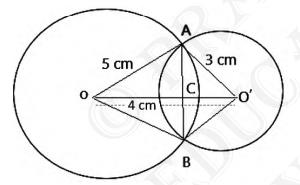
If two circles intersect each other at two points, then the line joining their centres is the perpendicular bisector of the common cord.
\(OO^{\prime} \) will be the perpendicular bisector of chord \(AB\)
\(\Rightarrow {AC}={CB}\)
Let \(OC\) be \(x \). Therefore, \( {O}^{\prime} {C} \) will be \( 4-{x} \)
In \( \triangle {OAC} \),
\({OA}^{2}={AC}^{2}+{OC}^{2}\)
\(\Rightarrow 5^{2}={AC}^{2}+{x}^{2}\)
\(\Rightarrow 25-{x}^{2}={AC}^{2}\quad \ldots\ldots\text{(i)}\)
Now, In \( \Delta {O}^{\prime} {AC} \),
\({O}^{\prime} {A}^{2}={AC}^{2}+{O}^{\prime} {C}^{2}\)
\(\Rightarrow 3^{2}={AC}^{2}+(4-{x})^{2}\)
\(\Rightarrow 9={AC}^{2}+16+{x}^{2}-8 {x}\)
\(\Rightarrow {AC}^{2}=-{x}^{2}-7+8 {x} \quad \ldots\ldots\text{(ii)}\)
From (i) and (ii), we get
\(25-x^{2}=-x^{2}-7+8 x\)
\(8 x=32\)
\(x=4\)
Hence, \( O^{\prime} C=4-4=0 {~cm} \) i.e. the common chord will pass through the centre of the smaller circle i.e., \( {O}^{\prime} \) and hence, it will be the diameter of the smaller circle.
Also, \( {AC}^{2}=25-{x}^{2} \)
\( =25-4^{2} \)
\( =25-16 \)
\( =9 \)
\( \Rightarrow {AC}=3 {~cm} \)
\( \Rightarrow \) Length of the common chord \( {AB}=2 {AC} \)
\( =(2 \times 3) {cm}=6 {~cm} \)
To prove: \( {PT}={RT} \)
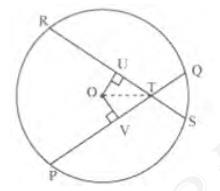
\({QT}={ST}\)
Draw perpendiculars OV and OU on these chords.
In \( \triangle {OVT} \) and \( \triangle {OUT} \),
\( {OV}={OU} \) (Equal chords of a circle are equidistant from the centre)
\( \angle {OVT}=\angle {OUT}\left(\text{Each } 90^{\circ}\right) \)
\( {OT}={OT} \) (Common)
\( \Delta {OVT} \cong \Delta {OUT} \) (RHS congruence rule)
\( {VT}={UT} \) (By CPCT) \(\quad \ldots\ldots\text{(i)}\)
It is given that,
\({PQ}={RS}\quad \ldots\ldots\text{(ii)}\)
\(\frac{1}{2} {PQ}=\frac{1}{2} {RS}\)
\({PV}={RU}\quad \ldots\ldots\text{(iii)}\)
On adding (i) and (iii), we get
\({PV}+{VT}={RU}+{UT}\)
\({PT}={RT}\quad \ldots\ldots\text{(iv)}\)
On subtracting equation (iv) from equation (ii), we obtain
\({PQ}-{PT}={RS}-{RT}\)
\({QT}={ST}\)
Therefore, \( {PT}={RT} \)
\( {QT}={ST} \) hence proved.
circle class 9 exercise 10.4 || class 9 circles exercise 10.4 || exercise 10.4 class 9 || class 9 exercise 10.4 || ncert class 9 exercise 10.4 || class 9 math exercise 10.4 || circles class 9 exercise 10.4 || class 9 maths chapter 10 exercise 10.4
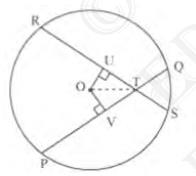
Draw perpendiculars OV and OU on these chords.
In \( \triangle {OVT} \) and \( \Delta {OUT} \),
\( {OV}={OU} \) (Equal chords of a circle are equidistant from the centre)
\( \angle {OVT}=\angle {OUT}\left(\text{Each } 90^{\circ}\right) \)
\( OT = OT\) (Common)
\( \Delta {OVT} \cong \Delta {OUT} \) (RHS congruence rule)
\( \angle {OTV}=\angle {OTU} \) (By congruent parts of congruent triangles)
Therefore, it is proved that the line joining the point of intersection to the centre makes equal angles with the chords.
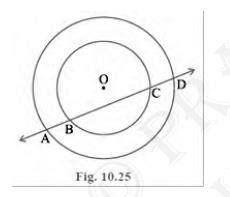
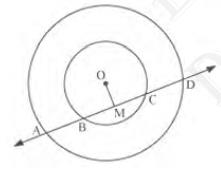
It can be observed that BC is the chord of the smaller circle and AD is the chord of the bigger circle
We know that perpendicular drawn from the centre of the circle bisects the chord
\({BM}={MC}\quad \ldots\ldots\text{(i)}\)
And \({AM}={MD}\quad \ldots\ldots\text{(ii)}\)
On subtracting (ii) from (i), we get
\({AM}-{BM}={MD}-{MC}\)
\({AB}={CD}\)
Hence proved
Given: Distance between Reshma and Salma and between Salma and Mandip is 6m
Diagram:
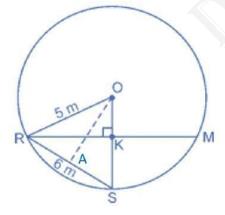
Explanation:
Draw perpendicular \(OA\) on \(RS\).
As \( OA \perp {RS} \),
\({RA}={AS}\)
Let \(R, S \) and \( M \) be the positions of Reshma, Salma and Mandip.
Now in \( \triangle {OAR} \) by Pythagoras theorem,
\({OR}^{2}={OA}^{2}+{RA}^{2}\)
\({OA}^{2}=5^{2}-3^{2}\)
\({OA}^{2}=25-9\)
\({OA}^{2}=16\)
\({OA}=4\)
Now we know,
Area of triangle \( =\frac{1}{2} \times {B} \times {H} \)
\(\text {Area }\Delta {ORS} =\frac{1}{2} \times {OS} \times {RK}\)
\(=\frac{1}{2} \times 5 \times {RK}\quad \ldots\ldots\text{(1)}\)
Also,
Area \( \triangle {ORS}=\frac{1}{2} \times {OA} \times {RS} \)
\(=\frac{1}{2} \times 4 \times 6\)
\(=12\quad \ldots\ldots\text{(2)}\)
From (1) and (2),
\(\frac{1}{2} \times 5 \times R K=12\)
\({RK}=\frac{12 \times 12}{5}\)
\({RK}=\frac{24}{5}\)
\({RK}=4.8 {~m}\)
As the perpendicular from the centre of a circle bisects the chord.
\(\text {As } {RM} =2 {RK}\)
\(= 2 \times 4.8\)
\(= 9.6 {~m}\)
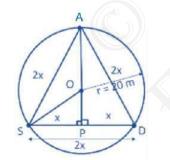
According to the given question,
\({AS}={AD}={SD}\)
Let \( {AS}={AD}={SD}=2 {x} \)
In \(ASD\), all sides are equal,
\( \therefore {ASD} \) is an equilateral triangle.
Now draw \( {OP} \perp {SD} \)
So, \( {SP}={DP}=\frac{1}{2} {SD} \)
\(\Rightarrow {SP}={DP}={x}\)
Join \(OS\) and \(AO\).
In \( \triangle OPS \),
\({OS}^{2}={OP}^{2}+{PS}^{2}\)
\((20)^{2}={OP}^{2}+{x}^{2}\)
\(400={OP}^{2}+{x}^{2}\)
In \( \triangle {APS} \),
\({AS}^{2}={AP}^{2}+{PS}^{2}\)
\((2 {x})^{2}={AP} ^{2}+{x} ^{2}\)
\(4 {x}^{2}={AP}^{2}+{x}^{2}\)
Now,
\(A P=A O+O P\)
\(\sqrt{3} x=20+\sqrt{400}-x^{2}\)
\(\sqrt{3} x-20=\sqrt{400}-x^{2}\)
Squaring both sides, we get,
\((\sqrt{3} x-20)^{2}=\left(\sqrt{400}-x^{2}\right)^{2}\)
\((\sqrt{3} x)^{2}+(20)^{2}-2 \times(\sqrt{3 x}) \times(20)=400-x^{2}\)
\(3 x^{2}+400-40 \sqrt{3} x=400-x^{2}\)
\(40 \sqrt{3} x=4 x^{2}\)
\(\frac{x^{2}}{x}=\frac{40 \sqrt{3}}{4}\)
\(x=10 \sqrt{3} m\)

